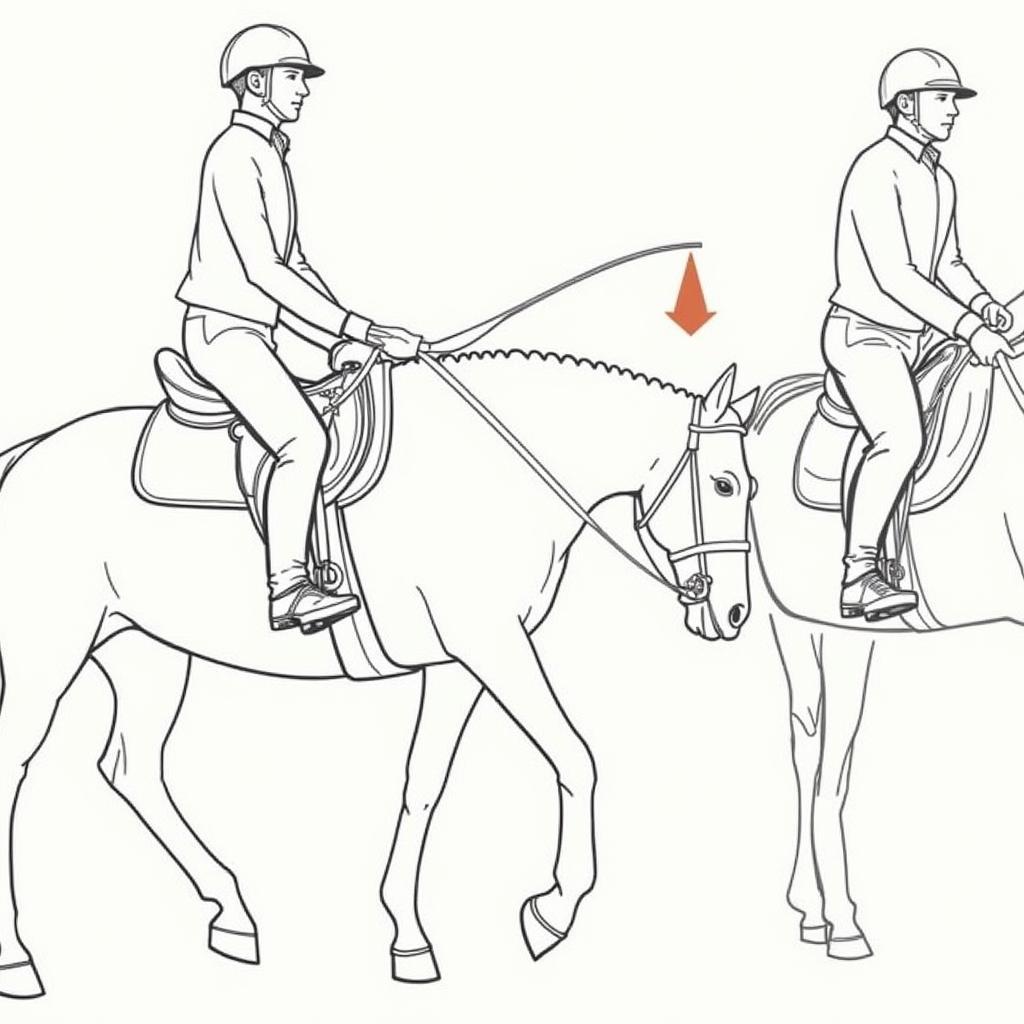Riding Crops For Horses are essential tools used by riders to cue and encourage their mounts. They are not instruments of punishment but rather aids for communication and reinforcement. Understanding their purpose, proper usage, and selection is crucial for any equestrian. Let’s delve into the world of riding crops and discover how they can enhance your riding experience.
Choosing the right riding crop can significantly impact your communication with your horse. While some crops are designed for specific disciplines like saddle seat horse riding, others are more general-purpose.
Types of Riding Crops and Their Uses
Riding crops come in various lengths, weights, and materials, each designed for specific purposes. Understanding these differences will help you select the most appropriate crop for your riding style and discipline.
Dressage Whips
Dressage whips are generally longer than other riding crops, typically around 47 inches. They are designed for precise cues and encouragement during dressage training, helping riders refine their horse’s movements and responsiveness.
Hunting Whips
Hunting whips are shorter and sturdier than dressage whips, often featuring a leather loop at the handle for a secure grip. They provide more substantial reinforcement and are commonly used in jumping and hunting disciplines.
Bat Crops/Schooling Whips
Bat crops, also known as schooling whips, offer a balance between length and weight. Their versatile design makes them suitable for various disciplines and training purposes, from flatwork to jumping.
Jumping Bats/Short Whips
Jumping bats are shorter, lightweight crops ideal for encouraging horses over fences. Their compact design allows for quick and precise cues during jumping exercises.
How to Properly Use a Riding Crop
Using a riding crop correctly is essential for effective communication and to avoid harming your horse. A riding crop should never be used as a punishment but rather as an extension of your leg aids, reinforcing cues and encouraging responsiveness.
Timing and Placement of Cues
The timing and placement of your cues are crucial. A tap behind your leg should coincide with your leg aid, reinforcing the request for forward movement or a change in gait. Avoid excessive or erratic use, which can confuse and desensitize your horse.
Maintaining a Soft and Supple Contact
Maintain a soft and consistent contact with your horse, even when using a riding crop. Avoid harsh or jerky movements that could startle or cause discomfort.
 Correct Technique for Using Riding Crops
Correct Technique for Using Riding Crops
“A riding crop is a tool for communication, not punishment,” says renowned equestrian trainer, Sarah Miller. “Used correctly, it can refine your horse’s responsiveness and enhance your riding experience.”
Selecting the Right Riding Crop for Your Needs
Choosing the right riding crop depends on various factors, including your riding discipline, the size and temperament of your horse, and your personal preference.
Considering Your Discipline
Different disciplines often favor specific types of crops. Dressage riders typically prefer longer whips for precise cues, while jumpers often opt for shorter, lighter bats for quick aids.
Matching the Crop to Your Horse
The size and temperament of your horse also play a role. A more sensitive horse might respond well to a lighter touch, while a less responsive horse may require a slightly heavier crop.
Personal Preference
Ultimately, your personal preference is also a factor. Experiment with different lengths, weights, and materials to find the crop that feels most comfortable and effective in your hand.
“Remember, the goal is clear communication, not force,” adds John Davies, a respected horse behaviorist. “A well-chosen and properly used riding crop can be a valuable tool in building a strong partnership with your horse.”
The history of horses in the renaissance demonstrates how riding aids have evolved over time. While the specific tools may have changed, the core principle of clear communication between horse and rider remains constant.
Conclusion
Riding crops for horses are valuable tools that, when used correctly, can enhance communication and improve the riding experience. By understanding their purpose, various types, and proper usage, you can select the right crop for your needs and build a stronger partnership with your horse. Choosing the right horse riding crops requires careful consideration, just like selecting appropriate horse riding stocks or driving equipment for horses.
FAQ
- What is the purpose of a riding crop? A riding crop is an aid for communication and reinforcement, not punishment.
- How long should a dressage whip be? Dressage whips are typically around 47 inches long.
- Are riding crops cruel? When used correctly, riding crops are not cruel. They are a means of communication.
- What is the difference between a bat crop and a jumping bat? Bat crops are longer and heavier than jumping bats.
- How do I choose the right riding crop? Consider your discipline, your horse, and your personal preference.
- Can I use a riding crop on a young horse? Yes, but with extreme caution and under the guidance of an experienced trainer.
- Where can I buy a riding crop? Tack shops and online retailers sell a variety of riding crops.
Looking for more information on horse riding equipment? Check out our other articles on our website.
Contact us for any assistance needed. Phone: 0772127271, Email: [email protected] or visit us at QGM2+WX2, Vị Trung, Vị Thuỷ, Hậu Giang, Việt Nam. We have a 24/7 customer service team.